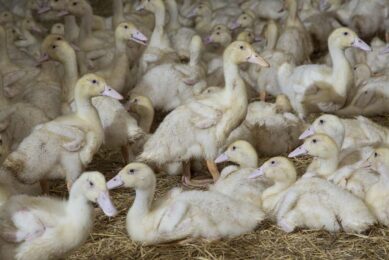Conflicts between veterinary and public health agencies emerge over HPAI.
The New Delhi meeting was arranged for representatives of eleven Asian nations to review the control and prevention of HPAI and hopefully resolve some conflicts. By Simon Shane
On Thursday 27th July a conference was arranged for representatives of eleven Asian nations to review the control and prevention of HPAI.
The objective of the event, which was organized jointly by the FAO and the WHO, was to coordinate activities of veterinary regulators and public health officials with regard to their relative responsibilities in the face of extensive and widespread outbreaks in poultry and the ongoing sporadic, extremely infrequent, low-level direct transmission to susceptible human contacts of infected domestic ducks and chickens.
From the outset of the AI panornitic in SE Asia in 2004 there has been a lack of coordination and understanding of the epidemiology of H5N1 infection among and between veterinarians and physicians. Conflicts have arisen within some countries as to the relevant responsibility and authority to suppress infection. The New Delhi meeting was intended to resolve some of the issues and to encourage the nations with incident cases to apply established principles of control, as modified by the lessons of the past three years.
Firstly it must be recognized that H5N1 infection is a disease of poultry. This presumes that qualified veterinary epidemiologists, well versed in the control of catastrophic diseases of avian species will represent the first line of defense. The simplistic doctrine of eradication of H5N1 infection by “stamping out” is inappropriate to the subsistence poultry populations of Vietnam, Thailand, China, Indonesia and India. The presence of large commercial production units in these countries with a high concentration of susceptible chickens is a further complication which negates the feasibility of complete and rapid eradication. Competent veterinary authorities would and should have adopted pre-emptive vaccination at the outset of the infection rather than attempting the expedient of protracted slaughter campaigns after the introduction of the virus into poultry populations. This approach has resulted in infection becoming endemic in subsistence poultry representing a danger to rural residents.
The dire prediction of the “inevitable” mutation of the H5N1 virus to become infectious to humans has not materialized and is unlikely to occur based on recent knowledge of the molecular biology of the virus. The threat of a human influenza pandemic does however justify developing appropriate contingency plans including early detection through surveillance, stockpiling antiviral medication and resources for treatment and accelerating production of vaccines for humans. These activities are the rightful responsibility of the WHO and the national agencies dealing with public health.
The best defense against human influenza of avian origin is to reduce the quantum of H5N1 virus in the poultry population. This can be achieved under the direction of trained, empowered veterinarians applying a coordinated program of detection through surveillance, pre-emptive vaccination, culling with fair compensation and strict quarantine of affected farms and limiting movement of live birds and products.
By: Simon Shane
The objective of the event, which was organized jointly by the FAO and the WHO, was to coordinate activities of veterinary regulators and public health officials with regard to their relative responsibilities in the face of extensive and widespread outbreaks in poultry and the ongoing sporadic, extremely infrequent, low-level direct transmission to susceptible human contacts of infected domestic ducks and chickens.
From the outset of the AI panornitic in SE Asia in 2004 there has been a lack of coordination and understanding of the epidemiology of H5N1 infection among and between veterinarians and physicians. Conflicts have arisen within some countries as to the relevant responsibility and authority to suppress infection. The New Delhi meeting was intended to resolve some of the issues and to encourage the nations with incident cases to apply established principles of control, as modified by the lessons of the past three years.
Firstly it must be recognized that H5N1 infection is a disease of poultry. This presumes that qualified veterinary epidemiologists, well versed in the control of catastrophic diseases of avian species will represent the first line of defense. The simplistic doctrine of eradication of H5N1 infection by “stamping out” is inappropriate to the subsistence poultry populations of Vietnam, Thailand, China, Indonesia and India. The presence of large commercial production units in these countries with a high concentration of susceptible chickens is a further complication which negates the feasibility of complete and rapid eradication. Competent veterinary authorities would and should have adopted pre-emptive vaccination at the outset of the infection rather than attempting the expedient of protracted slaughter campaigns after the introduction of the virus into poultry populations. This approach has resulted in infection becoming endemic in subsistence poultry representing a danger to rural residents.
The dire prediction of the “inevitable” mutation of the H5N1 virus to become infectious to humans has not materialized and is unlikely to occur based on recent knowledge of the molecular biology of the virus. The threat of a human influenza pandemic does however justify developing appropriate contingency plans including early detection through surveillance, stockpiling antiviral medication and resources for treatment and accelerating production of vaccines for humans. These activities are the rightful responsibility of the WHO and the national agencies dealing with public health.
The best defense against human influenza of avian origin is to reduce the quantum of H5N1 virus in the poultry population. This can be achieved under the direction of trained, empowered veterinarians applying a coordinated program of detection through surveillance, pre-emptive vaccination, culling with fair compensation and strict quarantine of affected farms and limiting movement of live birds and products.
By: Simon Shane
Join 31,000+ subscribers
Subscribe to our newsletter to stay updated about all the need-to-know content in the poultry sector, three times a week. Beheer
Beheer








 WP Admin
WP Admin  Bewerk bericht
Bewerk bericht